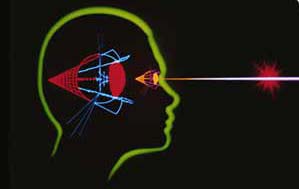“In high school, I was forbidden to wear glasses, so every girl seemed beautiful to me. But after graduation, how disappointed I was!” wrote the poet Denvich, a friend of poet Pushkin. Denvich found himself in this ironic situation because his nearsightedness made him “see chickens turning into phoenixes.”
 |
Nearsighted individuals see only close objects (Image: BBC) |
First of all, nearsighted individuals (of course, only when not wearing glasses) can never see the outer edges of objects clearly. For them, everything appears very blurry. A person with normal vision can distinguish each leaf and branch against the sky, while a nearsighted person sees only a vague mass of green without distinct shapes, resembling an unusual figure.
Nearsighted people perceive others as younger and more attractive simply because they cannot see wrinkles and small scars. To them, rough red skin becomes smooth pink.
Sometimes we are quite surprised when someone misjudges another person’s age by as much as ten years. We marvel at their peculiar aesthetic sense and may even find them rude for staring at us. This is because when they are not wearing glasses, they cannot see you at all. In all situations, they fail to notice details that you are sure they should see. To them, what they see is a vague image, nothing special; hence, when they meet you again an hour later, they may not recognize you. Most nearsighted people recognize others primarily by their voices rather than their appearances.
At night, for nearsighted individuals, all bright objects like street lights and indoor lamps appear enormous, while shadows become vague and shapeless. They fail to recognize oncoming cars and only see two glaring spots (the car’s headlights) against a backdrop of darkness.
The night sky looks vastly different to nearsighted individuals compared to those with normal vision. They can only see the largest stars. Thus, whereas there should be thousands of stars, they may only discern a few hundred. Through their eyes, these stars appear as gigantic glowing balls, while the moon looks very large and close; a crescent moon takes on a complicated, bizarre shape.
The cause of all these phenomena is due to a defect in the structure of a nearsighted person’s eye. Their eyes are too deep, causing light rays from each point on an object to converge incorrectly in front of the retina instead of directly on it. As a result, when the light reaches the retina at the back of the eye, it has already dispersed, forming a very blurry image on the retina.




















































